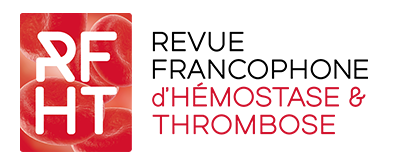RÉSUMÉ
Utilisé pour la prise en charge des thrombopénies induites par l’héparine, l’argatroban, anticoagulant anti-IIa direct administré en perfusion intraveineuse (IV) continue, a été récemment proposé comme anticoagulant de première intention pour la prise en charge des complications thrombotiques des patients présentant une Vaccine-induced Immune Thrombotic Thrombocytopenia (VITT) ; la thrombopénie doit être prise en charge en parallèle (par immunoglobulines IV, et éventuellement corticostéroïde). Un groupe ad hoc a été établi par le bureau du GFHT et l’avis de membres du GFHT sollicités via une enquête a pu être recueilli sur ces propositions. Pour la VITT, la dose initiale proposée est de 1,0 mg x kg-1 x min-1 à ajuster en fonction des résultats de laboratoire en liaison avec un praticien expérimenté en hémostase. Premier contrôle : 4 heures après le début de la perfusion puis contrôles réguliers toutes les 4 heures jusqu’à l’obtention de l’équilibre, puis au moins une fois par jour. L’obtention d’une anticoagulation efficace doit être rapide en cas de thrombose étendue, notamment en cas de thrombose veineuse cérébrale, fréquente et grave dans les VITT. Pour le suivi au laboratoire d’un patient avec VITT, il est préférable d’estimer la concentration plasmatique de l’argatroban par un test basé sur la mesure de l’activité anti-IIa, avec une zone cible comprise entre 0,5 et 1,5 mg/mL, à adapter en fonction des facteurs de risque hémorragique et thrombotique, et à réévaluer fréquemment, notamment en fonction de l’évolution clinique, de l’imagerie, et de la numération plaquettaire. Concernant le suivi avec le TCA, un TCA ratio compris entre 1,5 et 2,5 est proposé pour la VITT, en tenant compte de la sensibilité du réactif à l’argatroban ; prendre en compte aussi des anomalies sous-jacentes susceptibles de faire varier le TCA et mesurer en parallèle l’activité anti-IIa correspondante, le cas échéant dans un laboratoire de recours. Les ajustements posologiques sont effectués par paliers de 0,1 à 0,2 mg x kg-1 x min-1 en fonction de la posologie initiale, des résultats du laboratoire et du contexte, en s’aidant des nomogrammes pour régler le débit de perfusion (réglette disponible). Surveiller régulièrement l’hémogramme (Hb, plaquettes), le fibrinogène et la fonction hépatique, en tenant compte de l’évolution clinique, surtout si le patient est instable.
MOTS CLÉS
argatroban, COVID-19, thrombopénie, thrombose, vaccin, VITT
ABSTRACT
Used for the management of heparin-induced thrombocytopenia, argatroban is a direct thrombin inhibitor, administered as a continuous infusion (IV route). This drug was recently proposed as the non-heparin anticoagulant of choice for the management of patients diagnosed with Vaccine-induced Immune Thrombotic Thrombocytopenia (VITT); platelet counts should be simultaneously improved with prompt administration of IVIg, and concomitant therapy with steroids is often considered. An ad hoc committee of GFHT members has worked on proposals regarding the practical use of argatroban, based on previously released guidance for heparin-induced thrombocytopenia (HIT), and adapted for the management of patients with VITT. In case of VITT, the initial dose to be preferred is 1.0 mg x kg-1 x min-1, and dose-adjustments are based on iterative and frequent clinical and laboratory assessments. It is strongly advised to involve a health practitioner experienced in the management of difficult cases in haemostasis within a multidisciplinary team. The first laboratory control has to be performed 4h after the initiation of argatroban infusion, with further controls at 4-hour intervals until steady state, and at least once daily thereafter. Importantly, full anticoagulation must be rapidly achieved in case of widespread thrombosis, and a cerebral venous thrombosis (which is typical of VITT) should not call for an anticoagulation scheme that is too cautious. In addition to baseline laboratory assessment, laboratory monitoring of argatroban administration should rely on an anti-IIa assay (several are available and adequate), to determine argatroban plasma levels using a dedicated calibration, with a target range between 0.5 and 1.5 mg/mL. Desired argatroban plasma levels can be refined based on meticulous appraisal of risk factors for bleeding and thrombosis, on frequent reassessments of clinical status with appropriate vascular imaging, and on the temporal changes in daily platelet counts. Considering the use of aPTT, baseline value and possible causes for alterations of the clotting time must be taken into account. Specifically in case of VITT, an aPTT ratio (patient’s/mean normal clotting time) between 1.5 and 2.5 is suggested, to be refined according to the sensitivity of the reagent to the effect of a direct thrombin inhibitor. The sole use of aPTT is discouraged: one has to resort to a periodical check with an anti-IIa assay at least, with the help of a specialised laboratory if necessary. Dose modifications should proceed in a stepwise manner with 0.1 to 0.2 µg x kg-1 x min-1 up- or downward changes, taking into account the initial dose, laboratory results, and the whole individual setting. Nomograms are available to adjust the infusion rate. Haemoglobin levels, platelet counts, fibrinogen plasma levels and liver tests should be periodically checked, depending on the clinical status, the more so when unstable.
KEYWORDS
COVID-19, thrombocytopenia, thrombosis, vaccine, VITT

